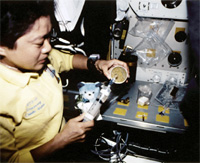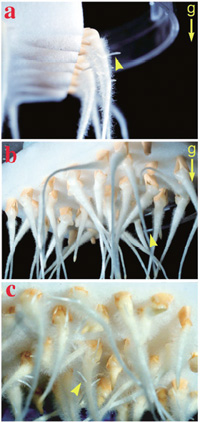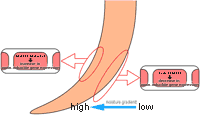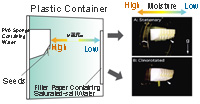This is an archive of information released in the past.
Disclaimer: It may contain broken links or outdated information. Some parts may not function in current web browsers.
*Visit https://humans-in-space.jaxa.jp/en/ for the latest information.

Experiment
- News
- Kibo Utilization Strategy
- Kibo Utilization Plan
- List of JAXA's Utilization Themes
- Experiment Facilities
- Space Environment Utilization
- Archive
News
- Experiment Successfully Completed (October 26, 2010)
Background

Figure 1. Astronaut Mukai conducting a plant experiment during the STS-95 mission

Figure 2. Root Growth in Space and on Earth
Astronaut Chiaki Mukai flew aboard the Space Shuttle (STS-95 Mission) from late October to early November of 1998. During the flight, she performed a space experiment with cucumber seeds proposed by Professor Hideyuki Takahashi. The experiment was designed to observe growth of cucumber seedlings. Aside from the original purpose, an interesting behavior of roots was observed during the experiment (Figure 1).
Cucumber seeds germinated and the seedlings grew in space. The directions in which the radicle first grow are predetermined. After a while, lateral roots grew out from the primary. During the experiment, however, the lateral roots diverted from the original directions and began to grow toward water in space (Figure 2).
It is thought that on Earth mainly gravity determines the orientation of root growth. Under microgravity conditions onboard the Space Shuttle, however, water seemed the only factor that determined the directions in which roots grew. Does this mean that in space we can see clearly what we cannot because of the presence of gravity on Earth ?
It is difficult to verify this idea on Earth, because the effect of gravity on root growth direction cannot be completely eliminated. Therefore, the relationship between water and root growth in microgravity will be studied onboard the International Space Station (ISS).
Objectives

Figure 3. How Auxin Acts and a Root Bends
One of the major purposes of this experiment is to see if roots of cucumber seedlings will bend toward water when they grow in microgravity.
Another purpose is to determine the mechanism by which roots bend. A root bends when its two sides grow differently. In other words, when the convex side grows faster then the concave side, the root bends as a result.
A plant hormone called "auxin" plays a role in this mechanism. Auxin promotes or suppresses plant growth depending on its concentration in plants. If auxin has a greater effect on one side of a root, growth on this side is suppressed. Then, why does auxin work differently in the two sides of the root? Do some hidden substances control the action of auxin ? It is another major purpose of the experiment to study the substances-the genes that control the action of auxin (Figure 3).
Experiments

Figure 4. How the Experiment Works
Duration of the experiment is about 2 days.
First, dried cucumber seeds will be inserted into PVA sponge (a porous material l that can readily hold water), and then, the PVA sponge with seeds will be placed in a container for launch.
In space, the experiment will start when water is poured onto the PVA sponge. The seeds will grow under an artificial gravity condition on a rotating rotor so that the roots will grow in the same direction.
After 18 hours, filter paper containing saturated-salt water will be placed on the opposite side of the container to the side where seeds are placed. The atmosphere inside the container will be dehumidified by the salt water. This humid absorption will create a moisture gradient between the supporting material containing water and the filter paper containing salt water. If the filter paper containing salt water is not present, there will be no moisture gradient in the container, in which humidity is kept high. Because roots grow toward the humid side in response to moisture gradient, in absence of moisture gradient, the interactive effects of gravity and water on root growth cannot be determined.
Samples of the roots will be collected 3 hours and then 24 hours after the filter paper containing salt water is placed. They will be refrigerated after being treated to preserve their conditions. In addition, images will be taken during the experiment (Figure 4).
Main Points of This Experiment !
Aims of this experiment cannot be achieved on Earth because the effects of gravity cannot be completely eliminated. The microgravity conditions of the ISS will make it possible to identify the effects of water on the growth of roots in the experiment.
If the mechanism by which roots respond to water is understood, it will be possible to use it for controlling the orientation of root growth under a particular environment such as plant factories in space in the future.
Organization
 |
Principal Investigator (PI)
Hideyuki TAKAHASHI Graduate School of Life Sciences, Tohoku University, Professor |
| Copyright 2007 Japan Aerospace Exploration Agency | Site Policy |